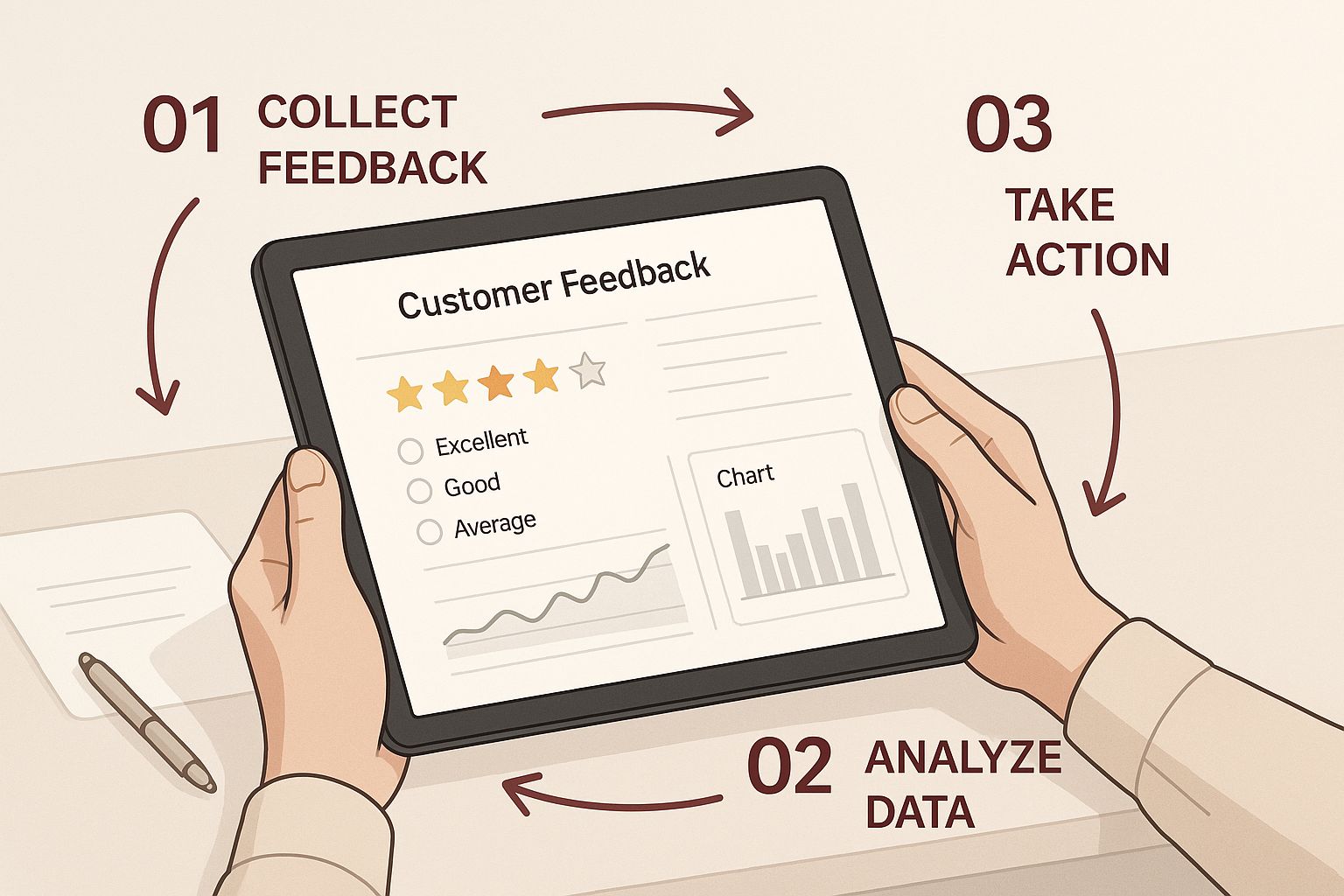Creating a solid buyer persona is more than just a marketing exercise; it's about digging deep into your target audience, sorting that data into meaningful groups, and then building out fictional but fact-based profiles of your ideal customers. These aren't just names on a page; they're detailed summaries of their goals, challenges, and what truly motivates them.
Moving Beyond Vague Customer Profiles
Let’s be honest, old-school customer profiles like "males, 18-35" are practically useless. They’re far too broad to inform any meaningful strategy. This guide is all about building detailed, data-driven buyer personas that feel like real people, because they’re based on them.
We're going to show you how a deep understanding of the 'who' behind your data can transform your marketing from a guessing game into a precise, effective conversation. Think of it this way: instead of shouting your message into a crowded room, you get to have a one-on-one chat with someone who actually wants to hear what you have to say.
Why Data-Driven Personas Matter
Vague descriptions lead to vague marketing. Simple as that. When you don't really know who you're talking to, your content becomes generic, your ad spend gets wasted, and your product roadmap starts to drift. Actionable personas, on the other hand, are built on a solid foundation of real customer insights.
"Customer-centric brands are known to be 60% more profitable on average than brands who devote less time to 'knowing their customers.' Buyer personas are the bridge to that understanding."
This whole process isn't about making assumptions; it's about validating your ideas with real-world facts. Imagine your entire organization, from marketing and sales all the way to product development, sharing the same deep understanding of the customer. Every decision suddenly becomes more aligned and impactful, ensuring everyone is working toward the same goal: serving your customer better.
What Makes a Persona Actionable
So, what separates a persona that just collects dust from one that your team actually uses? An actionable persona goes way beyond basic demographics. It paints a vivid picture of a real person with real-world problems and goals.
To be truly effective, your personas need to include a few key things:
- Goals and Motivations: What is this person trying to achieve in their life or career?
- Challenges and Pain Points: What obstacles are holding them back? Where does the frustration lie?
- Communication Preferences: Where do they hang out online and offline? Do they prefer detailed blog posts, quick videos, or scrolling through social media?
- A "Day in the Life" Narrative: What does a typical day look like for them? This context is absolutely crucial for building empathy.
To help you get started, here's a quick breakdown of the essential components you'll need to gather.
Key Components of an Actionable Buyer Persona
| Component Category | What to Include | Example Question to Ask |
|---|---|---|
| Demographics | Age, gender, location, income, education, family status. | "What's your household income, and where are you located?" |
| Professional Role | Job title, industry, company size, career path, key responsibilities. | "Can you walk me through your primary responsibilities at work?" |
| Goals & Motivations | Primary and secondary goals (personal & professional), what drives them. | "What would a 'win' look like for you in the next year?" |
| Challenges & Pain Points | Frustrations, obstacles, what keeps them up at night. | "What's the single biggest challenge you're facing in your role right now?" |
| Watering Holes | Social media platforms, news sources, blogs, influencers, conferences. | "Where do you go to learn about new trends in your industry?" |
| Communication Style | Preferred communication channels, tone (formal vs. informal), content formats. | "Do you prefer getting information through email, webinars, or short videos?" |
| Quotes & Stories | A direct quote that captures their personality and core problem. | "Can you share a specific story about a time you struggled with [problem]?" |
Having these components gives you a robust foundation. It turns a flat description into a three-dimensional character your team can relate to and design for.
This guide will walk you through the entire process, step-by-step. We’ll start with gathering real customer insights and finding the patterns hidden within. From there, we’ll move to crafting a compelling story for each persona and, most importantly, putting them to work to get actual results. Consider this your roadmap to creating personas your whole team will actually want to use.
Gathering Your Persona Research Materials

You don’t need a massive budget or a team of data scientists to get this done. The most powerful insights often come from practical, scrappy data collection, mixing the numbers you already have with real human stories. The goal is to build a complete picture of your customers by looking at what they do and listening to what they say.
This means starting with the resources right in front of you. Your best research materials are often hiding in plain sight.
Start With Your Existing Data
Before you even think about sending a survey, dig into your own analytics. Tools like Google Analytics are treasure troves of behavioral data that show you how people actually interact with your business, not just how they say they do.
Look for patterns in your website traffic. Where do most of your visitors come from? Which blog posts or pages keep them engaged the longest? What path do they take before they convert or drop off? This quantitative data gives you a solid, unbiased foundation for understanding user behavior.
Good personas are built by mixing this kind of quantitative data with qualitative insights from sources like market research and direct interviews. For example, analytics can show you demographic info and common user navigation paths. This data helps you spot trends and tailor your messaging. You can find more great insights on building data-driven personas from Magnolia CMS.
Tap Into Your Frontline Experts
Your sales and customer support teams are on the front lines every single day. They have unfiltered access to your customers' biggest questions, frustrations, and goals. These conversations are a goldmine of qualitative insights you can't get anywhere else.
Schedule short, informal chats with a few people from both departments. Don't come with a rigid script; just ask open-ended questions to get them talking.
Questions to Ask Your Sales & Support Teams:
- What are the most common questions you hear during a sales call?
- What are the biggest objections or hesitations that come up?
- Which features get customers most excited?
- What problems were customers trying to solve before they found us?
- Are there any "aha!" moments that consistently win people over?
These internal interviews bridge the gap between hard data and human reality. Your analytics can tell you what page a user left from, but your sales team can tell you why they probably left.
Use Surveys to Fill the Gaps
Once you’ve looked at your internal data and spoken with your teams, you can use short, targeted surveys to fill in any missing pieces. The key is to keep them brief and focused. People are busy, and nobody wants to fill out a 50-question form.
Use a tool like SurveyMonkey or Google Forms to create a simple survey with 5-7 essential questions that get to the heart of their motivations and challenges. It also helps to offer a small incentive, like a gift card or a discount, to boost your response rate.
By combining these three sources, your analytics, your team’s feedback, and direct customer input, you'll have all the raw materials needed to create personas that are both accurate and genuinely useful.
Turning Raw Data Into a Human Story
You’ve done the heavy lifting and gathered a ton of research. Now you're staring at a pile of analytics reports, survey answers, and interview notes. This is where the real work begins, and where the magic happens. It’s time to step away from the spreadsheets and start weaving all that raw information into a human story that your entire team can get behind.
First things first, you need to sift through everything you've collected and start looking for recurring themes. Don't get lost in the weeds of every single data point. Instead, you're on a hunt for the big patterns that connect different groups of your customers.
Are multiple people bringing up the same frustration in their interviews? Do you see a common goal popping up again and again in survey responses and sales call notes? These clusters of shared pain points, goals, and motivations are the bedrock of your personas. The idea is to group individuals who share these core characteristics. This is how you start to paint a clear picture of who you're actually talking to.
From Demographics to a Day-in-the-Life
It's tempting to stop at basic demographics like 'Marketing Manager, age 30-40,' but let's be honest, that doesn't really tell you much. To create a buyer persona that's actually useful, you have to dig deeper into their world. Give this person a name, a real job title, and a backstory.
Instead of a generic label, you might create 'Strategic Sarah.' From your survey data, you know she's obsessed with proving ROI. You know she’s wrestling with a tight budget because your sales team hears that same story every single day. This kind of detail transforms a vague concept into a flesh-and-blood character your team can actually picture.
This is exactly what the process looks like: taking scattered customer data from analytics and feedback forms and synthesizing it into a clear, actionable persona.

The image above really nails how you can translate all those disconnected data points into a cohesive story that actually guides your marketing decisions.
Structuring Your Persona Profile
Okay, now you need to get all these insights organized into a simple, shareable document. A good persona profile isn't just a boring list of facts; it’s a quick-reference guide that helps your team build genuine empathy. It needs to be scannable and easy to digest at a glance.
A great way to structure this is by breaking it down into clear sections. Think of it like a character sheet for your ideal customer.
Here are some of the most important sections to include:
- Background: Give some context. What's their job title, career path, and maybe a little about their family life? This adds a crucial layer of personal reality.
- Goals: What are they trying to accomplish? List both their primary and secondary objectives. For 'Strategic Sarah,' a primary goal might be to increase lead generation by 20% this quarter.
- Challenges: What's standing in their way? Identify their biggest frustrations at work or in life. This is where your product or service becomes the hero of their story.
- "A Day in the Life": This is my favorite part. Write a short narrative describing their typical day. It's an incredibly powerful tool for building empathy and truly understanding the daily pressures they face.
The most effective personas I've ever seen always include a direct quote that perfectly captures their core motivation or primary challenge. For Sarah, it might be something like, "I have all this data, but I struggle to turn it into a clear report that shows my team's impact on revenue."
A single sentence like that can be more powerful than a whole page of bullet points because it gives your persona a voice. It makes them feel real. By taking the time to build out these rich stories, you’re creating a powerful strategic tool that aligns your whole team and, most importantly, puts the customer at the center of every single decision you make.
Putting Your Buyer Personas Into Action
You've done the hard work and built out your buyer personas. That's a huge win, but they're completely worthless if they just sit in a Google Drive folder collecting digital dust. The real magic happens when you weave them into the fabric of your daily marketing strategy. This is the moment your research turns into a tool that drives actual results.
Think of your personas as your marketing compass. Every single time you brainstorm a new blog post, design an ad, or write an email, you should stop and ask, "What would 'Strategic Sarah' think of this?" This one simple question forces you to stay laser-focused on the people who matter most to your business.
Tailoring Your Content Strategy
Your personas should be the driving force behind every piece of content you create. If you know that 'Strategic Sarah' is obsessed with proving ROI, your next blog post better be a case study loaded with hard numbers, not a fluffy top-10 list. If 'Techie Tom' lives for data sheets and technical specs, you already know what to lead with for your next product launch.
This kind of insight lets you be surgically precise. You stop making generic content for a faceless crowd and start creating resources that speak directly to a specific person’s challenges and goals.
For example, you might adjust your content mix like this:
- For the data-driven executive: Double down on in-depth reports, whitepapers, and case studies that scream "measurable results."
- For the visual, hands-on manager: Create infographics, short video tutorials, and beautifully designed presentations.
- For the time-crunched professional: Focus on bite-sized content like quick tips on social media, short podcasts, or scannable email newsletters.
This targeted approach does more than just boost engagement; it builds genuine trust. Your audience starts to feel like you actually get them. If you want to dive deeper into this, check out our guide on creating engaging social media content that really connects with specific audience segments.
Personalizing Your Marketing Campaigns
Personas aren't just for content; they're your secret weapon for personalizing everything from ad targeting to email automation. Once you truly understand your persona's motivations, you can write ad copy that speaks directly to their biggest pain points. You can also dial in your ad targeting on platforms like Facebook and LinkedIn to reach audiences that mirror your persona’s demographic and professional profile.
Email marketing is where this really comes to life. Forget one-size-fits-all email blasts. Segmenting your list by persona allows you to send hyper-relevant messages that have a much better chance of being opened, read, and acted upon.
A well-defined persona is a filter. It helps you say "no" to the ideas that don't serve your ideal customer and "yes" to the ones that will build a real connection.
Look at the fintech banking app that completely redesigned its platform after doing deep user research. They found their pricing tiers were confusing, so they created new, tailored personas to guide a more personalized marketing push. The result? A projected 29% revenue growth and a 15% jump in new customer acquisition. This is proof that knowing your audience isn't just a marketing platitude, it's a fundamental driver of business growth.
Keeping Your Personas Fresh and Relevant

Building out your buyer personas is a huge step forward, but it's definitely not the finish line. Markets are constantly in flux. Customer needs change, new tech emerges, and behaviors shift. A persona that felt perfectly accurate last year might be just a little off today and completely out of date by next year.
That’s why you have to treat your personas as living documents. Think of them less as a project you file away and more as a strategic tool that needs regular tune-ups to stay effective. Keeping them current is what keeps your marketing genuinely connected to the people you’re trying to reach.
The good news? This doesn't have to be some monumental effort. With a couple of straightforward habits, you can keep a finger on the pulse of your audience and ensure your personas stay sharp.
Establish Simple Feedback Loops
One of the best and easiest ways to catch new trends is to listen to the people on your front lines. I’m talking about your sales and customer service teams. They’re the first to hear about new problems, different priorities, and what your customers are really thinking.
Try setting up a recurring, informal check-in. It doesn't need to be a formal meeting; a quick monthly chat or even a shared document where they can jot down insights works great.
Get the ball rolling with a few simple questions:
- Are you hearing any new objections or questions lately?
- Have you noticed a shift in what customers seem to care about most?
- Is there a new competitor that keeps popping up in conversation?
This kind of real-world, qualitative feedback is gold. It helps you pick up on subtle changes long before they ever appear in your analytics.
Monitor Your Data for Behavioral Shifts
While your team gives you the "why," your analytics will always give you the "what." Make a habit of regularly diving into your website, social media, and email marketing data. You're looking for any significant changes in how people are behaving.
A sudden drop-off on a previously popular page? A spike in engagement around a new topic? These are all potential signals that your audience’s needs are evolving.
Your personas are only as valuable as they are accurate. Scheduling a review every six to twelve months ensures they reflect reality, not history. This proactive approach keeps your entire strategy grounded in what your customers truly want right now.
This isn't just a hunch; the numbers back it up. Research shows that over 60% of companies that updated their buyer personas within the last six months beat their lead and revenue goals. What's more, high-performing companies often map over 90% of their customer database by persona. You can dig into more of this data on the impact of updated personas on Salesgenie's blog.
Ultimately, keeping your personas fresh is also great for your brand's public image. When you know exactly who you're talking to, your messaging resonates more positively. If you're interested in that side of things, our guide on online reputation management best practices is a great next step.
Common Questions About Buyer Personas
Even with the best instructions, creating buyer personas for the first time can feel a little fuzzy. You're trying to mix hard data with some creative thinking, and that's bound to raise a few questions. I've been there, and I’ve heard them all.
Let's clear up some of the most common hurdles people face. Getting these details right from the start will make sure the personas you build are actually useful for your team, not just a document that gathers digital dust.
How Many Buyer Personas Do I Need?
People always ask for a magic number, but there isn't one. A good rule of thumb, especially when you're starting out, is to aim for three to five personas. This is the sweet spot. It’s enough to cover your key customer segments without getting so granular that your team can't keep them straight.
If you try to create ten personas right out of the gate, your focus will be completely diluted. But if you only create one, you'll almost certainly miss huge chunks of your audience.
Start by mapping out the customer groups that bring in the most revenue or represent your biggest growth opportunities. You can always add more personas down the road as your business grows and you learn more.
Remember, a few deeply understood personas are infinitely more valuable than a dozen superficial ones. Quality over quantity, always.
What’s the Difference Between a Buyer Persona and a Target Audience?
This is a big one, and the distinction is critical. A target audience is a broad description based on demographics. Think "women, aged 25-40, who live in major cities and are interested in fitness." It tells you who is in your market, but not much else.
A buyer persona drills down and creates a semi-fictional character out of that audience. It gives that group a name, a face, and a story. We’re not just talking about demographics anymore; we're talking about their goals, motivations, and daily frustrations.
Here’s a simple way to think about it:
- Target Audience: The stadium you're playing in.
- Buyer Persona: The specific player on the field you’re trying to pass the ball to.
Your target audience helps you find the right pond to fish in. Your buyer personas tell you what kind of bait to use.
How Do I Get My Team to Actually Use the Personas?
This is probably the most important question of all. You can build the most beautiful, insightful personas in the world, but if they just sit in a folder, they're useless. Adoption is everything. The goal is to hear people in meetings say, "But would that actually solve a problem for Strategic Sarah?"
The secret? Don't just present the final personas to your team as a finished product. Involve them in the creation process from day one, especially people from sales, marketing, and product. When they have a hand in building them, they'll have a stake in using them.
Once the personas are ready, make them visible. Print out posters. Feature them in your internal newsletter. But most importantly, embed them into your workflows. Add a "Who is this for?" section to your project briefs that requires a specific persona. When you make them an official part of the process, they become a tool, not just an exercise.
At Digital Lotus Marketing, we specialize in creating data-driven marketing strategies that start with a deep understanding of your ideal customer. Let us help you build actionable buyer personas that drive real results. Learn more at https://digitallotusmarketing.com.





